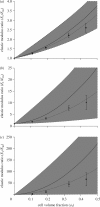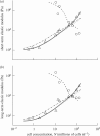Whole cell mechanics of contractile fibroblasts: relations between effective cellular and extracellular matrix moduli
- PMID: 20047943
- PMCID: PMC3263794
- DOI: 10.1098/rsta.2009.0240
Whole cell mechanics of contractile fibroblasts: relations between effective cellular and extracellular matrix moduli
Abstract
While much is known about the subcellular structures responsible for the mechanical functioning of a contractile fibroblast, debate exists about how these components combine to endow a cell with its form and mechanical function. We present an analysis of mechanical characterization experiments performed on bio-artificial tissue constructs, which we believe serve as a more realistic testing environment than two-dimensional cell culture. These model tissues capture many features of real tissues with the advantage that they can be engineered to model different physiological and pathological characteristics. We study here a model tissue consisting of reconstituted type I collagen and varying concentrations of activated contractile fibroblasts that is relevant to modelling different stages of wound healing. We applied this system to assess how cell and extracellular matrix (ECM) mechanics vary with cell concentration. Short-term and long-term moduli of the ECM were estimated through analytical and numerical analysis of two-phase elastic solids containing cell-shaped voids. The relative properties of cells were then deduced from the results of numerical analyses of two-phase elastic solids containing mechanically isotropic cells of varying modulus. With increasing cell concentration, the short-term and long-term tangent moduli of the reconstituted collagen ECM increased sharply from a baseline value, while those of the cells decreased monotonically.
Figures





References
-
- Beran M. J., Molyneux J. 1966. Use of classical variational principles to determine bounds for the effective bulk modulus in heterogeneous media. Q. Appl. Math. 24, 107118
-
- Budiansky B. 1965. On the elastic moduli of some heterogeneous materials. J. Mech. Phys. Solids 13, 223–227. (10.1016/0022-5096(65)90011-6) - DOI
Publication types
MeSH terms
Grants and funding
LinkOut - more resources
Full Text Sources

